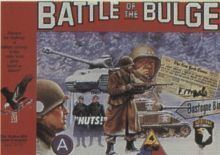Players 2 Setup time 10 minutes Random chance Medium | Age range 10 and up Playing time | |
 | ||
Skill(s) required Planning, Terrain control, Delay tactics | ||
Battle of the Bulge is a board wargame published by Avalon Hill as part of the Smithsonian American History Series. The game simulates the World War II battle of the same name and is designed for two players. It is based upon the general Avalon Hill system of combat and movement factors with a focus upon ease of play. The basic rules cover a single sheet of approximately legal-sized paper.
Contents
Aggressive gameplay is required by the German player, who must exceed the historical success of his forces. The American player must be able to transition from delaying tactics in the early game to assaults once force superiority is gained. The rules provide for a short game covering the initial five days of the battle (beginning 1944 December 12-16), a mid-length game covering the Allied counterattack, including the encirclement of the 101st Airborne Division, and a long game covering 16 days. Advanced game rules include air power, supply, and fuel usage.
Board
The gameboard covers portions of Germany, Luxembourg, and Belgium known as the Ardennes forest with a hexagonal grid. Geographic features include hills, forests, and rivers. Additional features like roads, cities, and fortifications are also provided. Important victory objectives like Bastogne are noted directly on the board.
Counters
Double-sided cardboard counters represent land units from divisional to regimental levels. Major units are 3/4" square in size, minor units 1/2" square. Additional counters denote damage and fortification, and in the advanced game, supply, fuel, aircraft, commando units, and more.
Setup
Gameplay always begins with the historical order of battle in historical positions. Reinforcements enter the field of battle on historical dates but generally possess some flexibility regarding entry position.
Movement
Movement in Battle of the Bulge is not dice-dependent but rather based upon a fixed value per unit. Total movement is dictated by terrain and enemy zones of control, the six hexes adjacent to every enemy unit. For example, fording a river necessarily slows a unit. Roads allow units to move at faster rates. Zones of control add an additional penalty for each such hex entered or exited, though the penalty does not stack. Additionally, units which avoid zones of control entirely for a turn gain movement point bonuses which are further amplified if only road movement is used. These bonuses effectively prevent that unit from entering combat for that turn. Movement is never mandatory, and any or all units may be moved each turn. Units may move over friendly units while moving (never enemy units) but must end their movement unstacked.
Combat
After movement is completed for all units, a player may elect to enter combat with any units adjacent to enemy units. Combat is resolved by each side totalling their combat modifier, based on the unit's printed combat factor, and adding it to a ten-sided die. Combat factors are modified by terrain, fortifications, and previous damage taken. Additionally, the attacker may combine multiple units into a single attack.
Combat results are based on the difference between the modified die rolls. All differences require retreats, moderate differences require an additional one step of damage, and large differences require a total of two steps of damage. The attacker does not move on a retreat; he is considered to have retreated from the attacked hex to where he began the attack. Large units (generally divisions) may take four steps of damage before being destroyed; smaller units (typically regiments) are destroyed by the first step of damage received.
